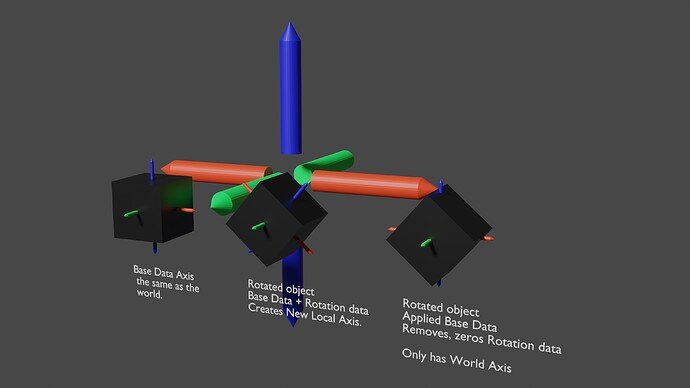-
Unlike the guy from the course, I didn’t end up with two squares at the bottom of the wedge, because I resized the cube (in Edit Mode) in the X, Y and Z axes before doing the edge grabbing: [G] [Z] [-4]. Therefore, was my approach better? Or is there a downside to the way I did it?
-
The things the guy says about so-called “mesh data” and scale/size value stuff around 2:30 at the beginning confuses me. During the first section, I’ve always just used scaling in Object Mode, and I thought that actually changed the size. And in practice, it clearly looks as if it’s actually changing in size. The stuff the guy says sounds a bit confusing and quite abstract, and I’m not sure I understand it now.
There are lots of ways of doing things in Blender, especially the simplest like this wedge. Your way is fine so long as you are aware you may have to apply the rotations and scales.
Applying the rotation and scale
It is to do with base data.
An object has a base state, place position rotation etc. Scale is all 1. Rotation zero. The display though reads the scaling and rotation added later to place it in the world. All works fine. What is more, the object still sees its own world in a local way like it was relative to itself before it was changed. So for a cube left/right X-axis is still lined up with its left and right sides. Even when it is in fact rotated and the world X-axis is completely different. Creating what is called it’s local axes.
Now the problems with this is all modifiers and most tools use the base data to act upon. So basically not the rotation and scale you actually mean it to use. It is one of the most common reasons tools do not do what was expected. Scale and rotations were not applied. This means Blender has not been told the rotation and scale you did are what you now want the position and orientation of the object to be.
You may wonder why it is not all automatically Applied rotations and scales. There are cases particularly the use of local axes that are very useful that they are not. Experience really will get you used to when not to apply. Most often it will be, this tool is not behaving correctly, best check rotation and scale ate applied!
In addition to NP5.
The Blender object has a lot of properties, like color, texture … and also height, width, scale …
And an object has MESH data (that is what you see when editing an object).
These vertices, edges, and faces have also a scale and dimensions.
But they don’t have to match the object properties!
When they don’t you can have strange results.
That’s why we say, apply the SCALE of the object.
Why blender has such logic, is how 3D structures work when doing the manipulation maths.
It will come to you, after more experience and Blender fucntions.


